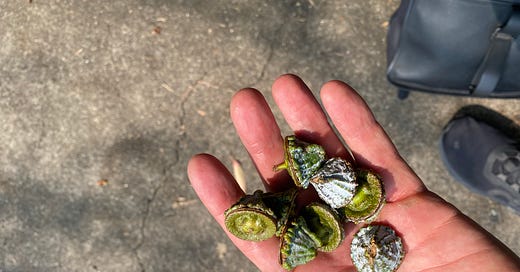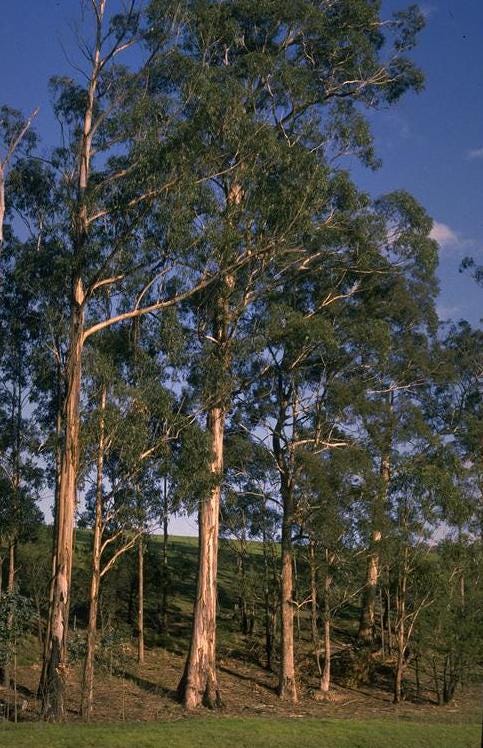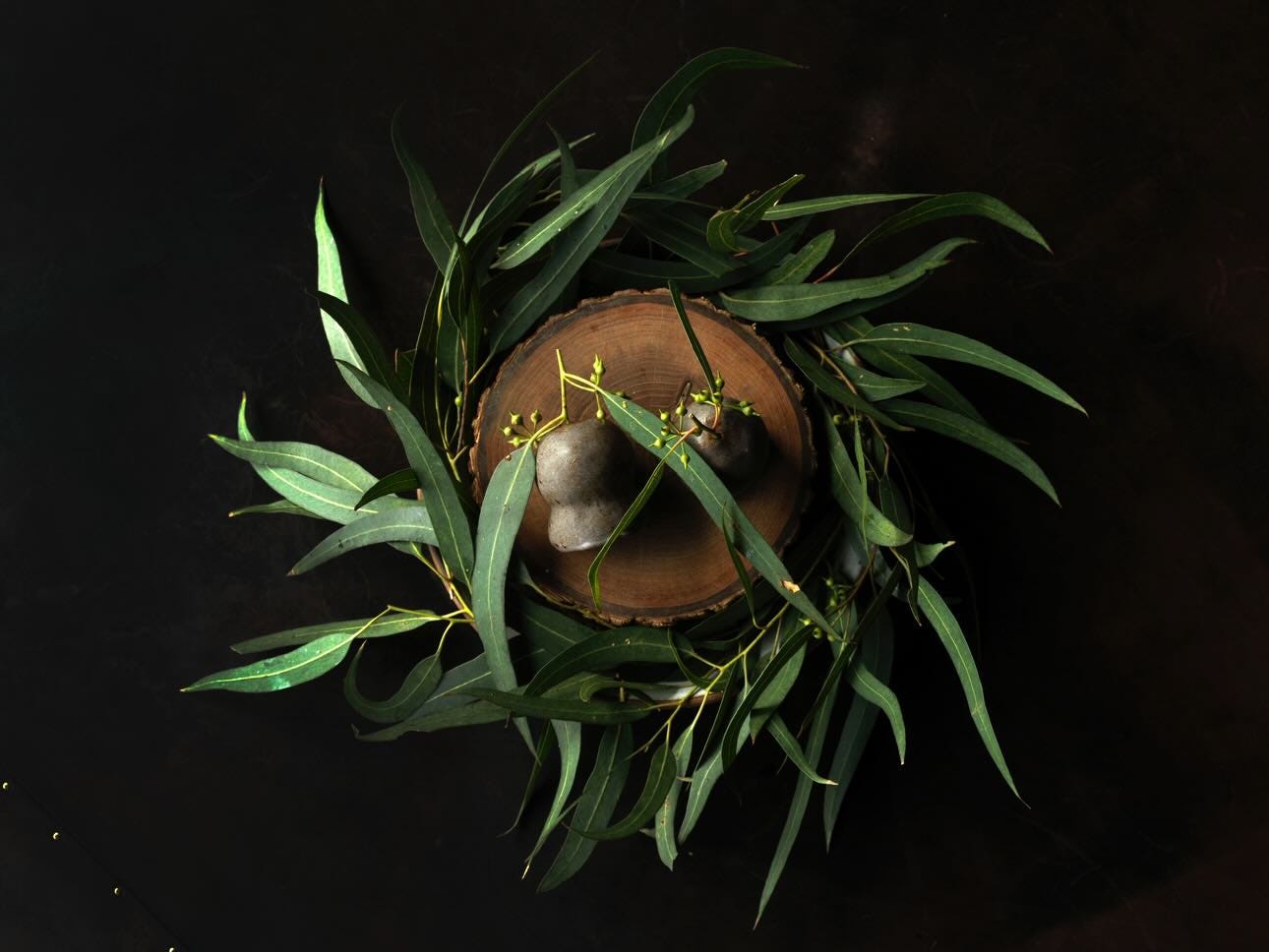A locally foraged ingredient with an aroma that trumps any commercial scent on the market.
You’re sooner to detect the aroma of eucalyptus before spotting it. This time of year, the trees, which are endemic to Australia, give off an unmistakably perfumed scent with hints of green citrus, avocado, mint and honey. While eucalyptus is most commonly used as an essential oil, eucalyptus leaves and fruits have culinary uses too. Not to mention, being a foraged hack to have your home smelling like a forest Down Under.
Last month, after a long day of driving, window ajar, tired and somewhat oblivious to my surroundings, I was met by the sudden hit of freshness that could only emanate from one thing…the eucalyptus tree. It was a reminder of its presence and my whereabouts; like an unplanned encounter with a friend, I was instantly smiling in appreciation. On my daily commute, I walk by a eucalyptus tree that greets me with its welcoming aroma. It’s a small moment between the tree and I, causing me to pause and appreciate its presence. I often look down, inspecting its dried-up fallen leaves, before craning my neck up at its canopy, not sure of whether I’m watching out for seasonal change or simply saying hello back. Since eucalyptus is evergreen, there is seldom much change. However, a few weeks had gone by, and no different to any other day, as I passed ‘my tree’, I noticed something unusual on the ground. Next to the discoloured, elongated and curved leaves were vividly blue-green half-moon capsules. There were lots of them dotted across the path, like small flying saucers or a spiny dragon's scales. I picked one up and like an animal approaching the unknown, cautiously took it to my nose to inspect. I was greeted by the pungent aroma of fresh eucalyptus. I looked up at the tree, almost questioning what it had offered me today or perhaps asking permission to take a couple home. As the tree waved in the wind, I took it as a sign of permission, and with that, picked up a couple of nature’s artefacts, placing them in my bag along with the rest of my shopping.
That afternoon, I went about researching the capsules (or whatever they were). I had cooked with eucalyptus leaves before to smoke leeks, as well as infusing them into oil to brush red mullet and cook it ‘en papillote’. The aromatic fish was then paired with tapioca pearls, cooked in roasted fish stock with pimenton, fried garlic and oregano - a delicious combination. But these capsules were not something I had come across before in my cooking. According to Google, they were in fact woody fruits, each containing numerous 1-3 mm long seeds, which the tree uses to propagate. In Australia they are referred to as gumnuts. The blueish globular gumnuts are unique to the species of that tree, appropriately named ‘eucalyptus globulus’ or ‘blue gum eucalyptus’. There are more than 700 species of eucalyptus, each with their own budding fruit, and most are native to Australia. As for when and where they first appeared in Ireland, Teagasc, the Agriculture and Food Development Authority states, “The first report of Eucalyptus planting in Ireland was of Eucalyptus globulus at Garron tower in Antrim in 1857... Perhaps the most well known are a series of trial plots planted in 1934/35 to 1937 at Ballymanus, in Glenealy Forest in Co. Wicklow.” Today they are being experimented with as a possible forest biomass species.
As I sat at my desk, pondering what could be done with these newfound fruits, my thoughts channelled the aroma rather than taste. I have a diffuser at home which I occasionally light. It's a ceramic vessel activated by the use of a tealight. There’s a crevice at the top of the vessel which holds oil. The heat from the tealight’s flame warms the clay, causing the oil to emit an aroma. The scent I have been using is fig leaf. It's a commercial oil, which to be honest, I am not very partial to. Rather than smelling of fig leaf, it emits an overly pungent aroma likened to a car air freshener (something that caused car sickness as a child). I thought, perhaps if I placed a gumnut in the diffuser's cavity, the heat might extract the natural oils and resins in the fruit. I tried it. After ten minutes of continuous heat (and checking)…nothing…the ceramic was warm, but there was no aroma. Eva, my partner, always with great ideas, suggested I add a little oil. We applied a half teaspoon of olive oil and within a matter of minutes, the entire room smelled of ‘my tree’. I quickly headed off to the tree and collected the remaining fruits. They now sit in my freezer in a zip-lock bag, which I suspect may preserve their freshness to be used as needed.
The health benefits of eucalyptus are well documented. Eucalyptus contains eucalyptol (also called cineole), an organic compound that can become toxic in high doses. The eucalyptol in eucalyptus is a powerful antiseptic. However, the same properties that make eucalyptus so potent as a germ killer also make it irritating in higher-than-normal doses. Many sources claim that eucalyptus leaves are not safe for humans to eat, while also declaring that eucalyptus tea (made by infusing dried leaves with water) contains a safe amount of eucalyptus oil. The oil is said to soothe coughs, repel mosquitos, deter dermatitis, aid with pain management and inflammation, and provide oral health amongst a lot more. It’s found in many kinds of medication. Using eucalyptus in a diffuser can help clear the sinuses and promote easier breathing, making it beneficial for respiratory health. Eucalyptus oil in the diffuser may also create a calming and relaxing atmosphere, reducing stress and improving overall wellbeing. Its pleasant scent can uplift your mood and aid concentration. So synonymous now with health, to think that the oil could be ingested might seem counterintuitive.
Today there is a conflict of understanding between taste and aroma. Ingredients like eucalyptus, lavender, bergamot or orange blossom, we now associate with the fragrance industry rather than the flavour industry. Hoping to find out more about the culinary uses of eucalyptus, I consulted with Australian chef and friend Hugh Allen, who is the CDC of Vue de Monde in Melbourne. Apart from making it into a spray for the oshibori hand towels they serve at the restaurant, he informed me about how common an ingredient it is in Australian cooking. Traditionally, it is often used to smoke ingredients, but at Vue de Monde, they used the oil to flavour a petit four. “There are many different types of eucalyptus that have very different flavours: Eucalyptus Olida, which tastes like strawberry bubblegum, and ‘peppermint gum’ or Eucalyptus radiata, which obviously has notes of mint and eucalyptus. We often use it in biscuits, (served) with chocolate and also in teas. A little petit four we did in the past was a ‘gumnut’ made from sheep's yoghurt and strawberry gum mousse.” Sounds divine.








Off out now to search for gum nuts!! Brilliant as always ! Grma